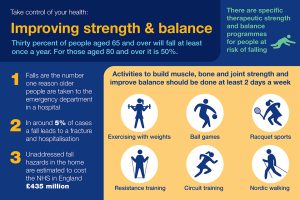Fall Prevention
Falls can happen in the home and when we are out and about, sometimes they are unavoidable, after all we have all experienced a momentary trip for many reasons and hopefully we recover our balance before we topple and thereby avoid injury.
However as we age we can become more vulnerable and at risk of falling, the aging process can lead to losses in muscle mass, decreased bone density and the slowing of our reflexes.
We may not realise that perhaps our homes need to be surveyed for falls risks and perhaps loose carpets, the layout of furniture, and the storage of daily household implements might need to be changed to make our journeys around the home safer.
Here are some statistics that will give you an idea of the impact, both to people and resources, when it comes to falls and their effect:
- People over the age of 65 experience falls the most
- 1/3 of over 65s fall at least once per year
- ½ of over 80s fall at least once per year
- Falls cause injury, pain, distress, loss of confidence and potentially independence and the risk of mortality.
- A&E admission between 2017-2018 in the over 65s was in the region of 350,000.
- “Fragility” fractures cost the nation £4.4 billion per year.
- For people over 65 long term outlooks for people following hip fractures are generally poor with negative impacts on activities of daily living and attempts at getting or remaining active.

What you can do?
Be Active
Just like machinery our bodies work best when they move. Movement stimulates circulation and good blood flow nourishes all our organs and muscles. Being active doesn`t mean you have to join a gym, it means taking advantage of things in your everyday life that can be used as an opportunity to move and raise your heart rate a little. Save a number of household jobs so you have an extended time in which to complete them, put some music on and make a mini home workout out of it, gardening is a great opportunity to be active and has the added value of being in the fresh air and of course active transport [otherwise known as walking or cycling] when done regularly can make enormous improvements in your fitness.
Be Strong
Resistance training is the same as weight training but don`t have images of heaving enormous barbells around! Simply challenging your larger muscle groups like those in your arms and legs etc. with a slightly challenging load with regularity can counter the muscle loss that can be a part of the ageing process.
Be Confident
Generally just by trying the above ideas a persons confidence in their physical capacity can increase and that in turn can motivate them to maintain an active lifestyle, quite a nice cycle to be caught in!
If you are in or Moving towards the age group where falls may become more of a risk then why not consider referring yourself to the Wellness Service? Here is a link that will help you to do this. Speak with one of our Health Coaches if you have the goal of becoming more physically active but are not quite sure where to start.
There may be other reasons why you might feel you are at risk of falls. Certain medical conditions can put you at risk, for example arthritic conditions can also affect younger people and there are certain medical treatments that result in people losing physical capacity that can increase their risk of falls. If you are affected in this way you too could consider self referring to the Wellness Service.
Here is the link: www.kirkleeswellnessservice.co.uk
Resources:
The NHS website has information and advice on falls prevention.
The CSP’s Get up and go – a guide to staying steady is a 32-page guide for the public and patients on how to prevent falls, produced by Saga in partnership with the CSP and the Office for Health Improvement and Disparities (OHID).
Age UK provides information and advice on falls prevention. RoSPA provides advice on how to make the home a safer environment. NHS Rightcare Falls and Fragility Fractures pathway (2017) NICE Impact Falls and Fractures. Royal Osteoporosis Society Clinical Guidance ‘A Safe Home’ provides information on preventing falls at home developed by NHS 24’s Scottish Centre for Telehealth and Telecare (SCTT). Spot the Hazard is a game about spotting falls hazards in the home.
The Active at Home booklet, updated in August 2021, provides practical guidance to older adults on home-based activities to maintain their strength and balance. It follows concerns that low levels of physical activity in older adults will lead to reduced fitness, resulting in loss of independence and need for care in the future.
The Keeping Well at Home guide, published in 2020, was produced by University of Manchester. It has been recently been updated to Keeping Well this Winter with tips and advice on keeping active and connected, staying safe and well, and managing our money and home.
The ‘Talking about Keeping Well this Winter’ film was made by older adults with tips on opening up a positive conversation on the doorstep or over the phone.
Watch the Talking about Keeping Well this Winter film
Better Health on the NHS website provides advice on healthy changes with free tools and support.
See our latest blog about Balance here: https://kirkleeswellnessservice.co.uk/get-some-balance-into-your-life/
